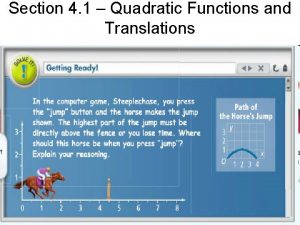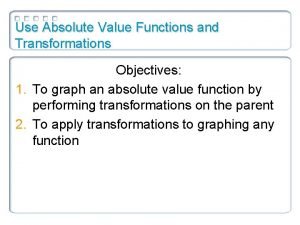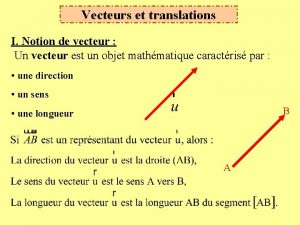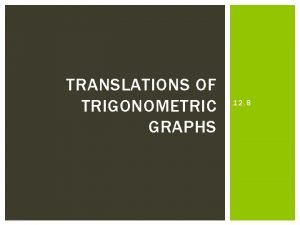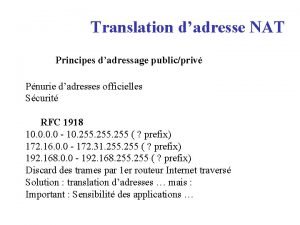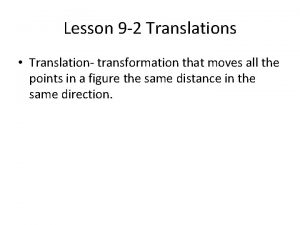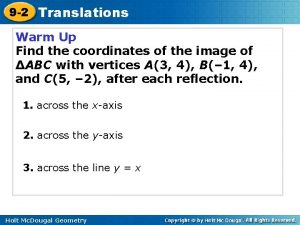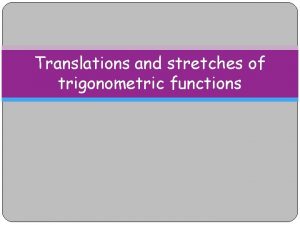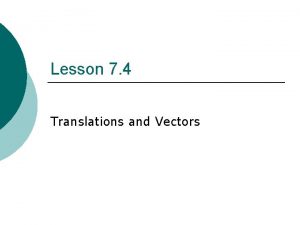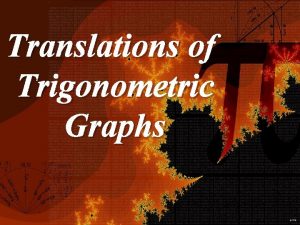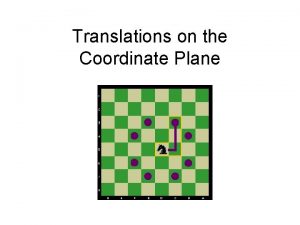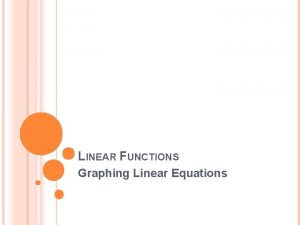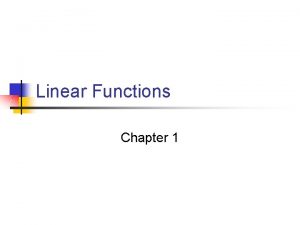TRANSLATIONS OF LINEAR FUNCTIONS Modified LTF activity 1



























- Slides: 27

TRANSLATIONS OF LINEAR FUNCTIONS Modified LTF activity

#1 Graph y = 2 x. Plot at least 5 points

#1 Graph y = 2 x. Plot at least 5 points On the same graph, translate the graph 4 units to the right by moving each point 4 units to the right.

#1 Graph y = 2 x. Plot at least 5 points On the same graph, translate the graph 4 units to the right by moving each point 4 units to the right. After the translation, what is the “new” location of the point (0, 0)?

#1 Graph y = 2 x. Plot at least 5 points On the same graph, translate the graph 4 units to the right by moving each point 4 units to the right. After the translation, what is the “new” location of the point (0, 0)? Write the equation of the translated line in slopeintercept form.

#1 Graph y = 2 x. Plot at least 5 points On the same graph, translate the graph 4 units to the right by moving each point 4 units to the right. After the translation, what is the “new” location of the point (0, 0)? Write the equation of the translated line in slopeintercept form. We can factor out the common factor in the translated equation to write a new equation.

#1 Graph y = 2 x. Plot at least 5 points On the same graph, translate the graph 4 units to the right by moving each point 4 units to the right. After the translation, what is the “new” location of the point (0, 0)? Write the equation of the translated line in slopeintercept form. We can factor out the common factor in the translated equation to write a new equation. New equation: y = 2(x – 4)

#1 Graph y = 2 x. Plot at least 5 points On the same graph, translate the graph 4 units to the right by moving each point 4 units to the right. After the translation, what is the “new” location of the point (0, 0)? Write the equation of the translated line in slopeintercept form. We can factor out the common factor in the translated equation to write a new equation. New equation: y = 2(x – 4) We moved the line 4 units to the right. Where does this important value appear in the new equation?

#2 Graph y = 2 x again. Plot at least 5 points

#2 Graph y = 2 x again. Plot at least 5 points On the same graph, translate the graph 4 units to the left by moving each point 4 units to the left.

#2 Graph y = 2 x again. Plot at least 5 points On the same graph, translate the graph 4 units to the left by moving each point 4 units to the left. After the translation, what is the “new” location of the point (0, 0)?

#2 Graph y = 2 x again. Plot at least 5 points On the same graph, translate the graph 4 units to the left by moving each point 4 units to the left. After the translation, what is the “new” location of the point (0, 0)? Write the equation of the translated line in slopeintercept form.

#2 Graph y = 2 x again. Plot at least 5 points On the same graph, translate the graph 4 units to the left by moving each point 4 units to the left. After the translation, what is the “new” location of the point (0, 0)? Write the equation of the translated line in slopeintercept form. We can factor out the common factor in the translated equation to write a new equation.

#2 Graph y = 2 x again. Plot at least 5 points On the same graph, translate the graph 4 units to the left by moving each point 4 units to the left. After the translation, what is the “new” location of the point (0, 0)? Write the equation of the translated line in slopeintercept form. We can factor out the common factor in the translated equation to write a new equation. New equation: y = 2(x + 4)

#2 Graph y = 2 x again. Plot at least 5 points On the same graph, translate the graph 4 units to the left by moving each point 4 units to the left. After the translation, what is the “new” location of the point (0, 0)? Write the equation of the translated line in slopeintercept form. We can factor out the common factor in the translated equation to write a new equation. New equation: y = 2(x + 4) We moved the line 4 units to the left. Where does this important value appear in the new equation?

#3 Answer these reflection questions For #1 and #2, the only difference was the direction the graphs moved. What is the only difference in the two new equations? Did addition correspond to moving left or right? What about subtraction? Is that what you would have expected? What is the significance of the common factor (the number outside the parenthesis)?

#4 Try listing key information without graphing! Equation 1. y = 3(x - 2) 2. y = 4(x + 2) 3. y = 10(x - 3) 4. y = ½(x + 3) 5. y = ½(x - 5) Slope Translation “New” location of (0, 0)

#5 Graph y = ¼ x. Plot at least 4 points.

#5 Graph y = ¼ x. Plot at least 4 points. On the same graph, translate the line to the right 2 units and up 3 units.

#5 Graph y = ¼ x. Plot at least 4 points. On the same graph, translate the line to the right 2 units and up 3 units. We know that the horizontal translation is an x movement and shows up as y = ¼ (x – 2). The vertical translation will appear next to y. Do you think it will be y + 3 or y – 3?

#5 Graph y = ¼ x. Plot at least 4 points. On the same graph, translate the line to the right 2 units and up 3 units. We know that the horizontal translation is an x movement and shows up as y = ¼ (x – 2). The vertical translation will appear next to y. Do you think it will be y + 3 or y – 3? Point-Slope Equation: y – 3 = ¼ (x – 2)

#5 Graph y = ¼ x. Plot at least 4 points. On the same graph, translate the line to the right 2 units and up 3 units. We know that the horizontal translation is an x movement and shows up as y = ¼ (x – 2). The vertical translation will appear next to y. Do you think it will be y + 3 or y – 3? Point-Slope Equation: y – 3 = ¼ (x – 2) The “new” (0, 0) is now at (2, 3). How does this point show up in the equation?

#6 – Try this one on your own! Graph y = 3 x. Plot at least 4 points. Translate the line 1 unit left and 3 units down. Write the point-slope equation of the translated line. What is the slope of this line? What point do we know for sure is on the line based on the equation?

#7 – Can you fill in the table? Equation y – 3 = 4(x + 2) y + 4 = 2(x – 1) y + 5 = 3 x y– 7=x+5 y = -2(x – 3) Slope Point on Line Translation

Notes This equation that shows the translation is written as y – y 1 = m(x – x 1) and is called POINT-SLOPE FORM. The m stands for slope. The (x 1 , y 1 ) represents one point on the line. When we use point-slope form in application, we no longer care about the “original” line and the translation. Instead we want to make sure we can name the slope and one point.

#8 – Can you write the equation? Slope Point 5 (3, 5) 7 (-5, 9) -2 (2, -4) 1 (-3, -3) -1/2 (0, 4) Equation

#9 – Can you write it from this format? GIVEN TWO POINTS: (4, 5) AND (3, -2) FOR EACH FORMAT, YOU NEED TO FIND SLOPE AND CHOOSE ONE POINT. THIS IS ENOUGH INFORMATION TO WRITE THE POINT-SLOPE EQUATION.
 1988. gada 8.-9. oktobris
1988. gada 8.-9. oktobris Planar segiempat
Planar segiempat Horizontal phase shift
Horizontal phase shift Translations of quadratic functions
Translations of quadratic functions Parent function of absolute value
Parent function of absolute value Vecteurs et translation
Vecteurs et translation Dilations translations rotations and reflections
Dilations translations rotations and reflections 12-8 translations of trigonometric graphs answers
12-8 translations of trigonometric graphs answers Show ip nat translations
Show ip nat translations Translations reflections and rotations
Translations reflections and rotations It is the translations between user and system?
It is the translations between user and system? 9-2 translations
9-2 translations Lesson 9-2 translations answers
Lesson 9-2 translations answers Relation de chasles
Relation de chasles 9-2 translations
9-2 translations 9-2 translations
9-2 translations Rotation reflection translation dilation
Rotation reflection translation dilation Translations rotations and reflections
Translations rotations and reflections Translations and reflections
Translations and reflections Translations in art
Translations in art Properties of translations
Properties of translations 9-2 translations
9-2 translations Congruence transformation definition
Congruence transformation definition Vertex of absolute value function
Vertex of absolute value function Vecteurs et translations
Vecteurs et translations Translations brian friel summary
Translations brian friel summary Lesson 1 translations
Lesson 1 translations Turkish bible translations
Turkish bible translations



